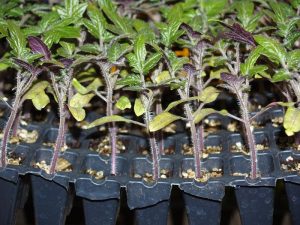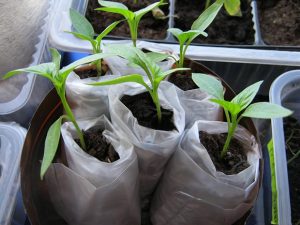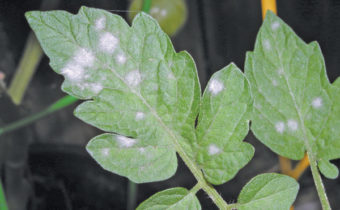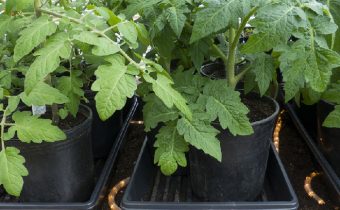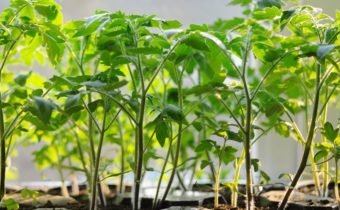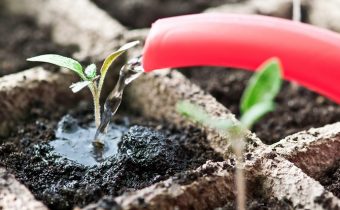Ways to grow tomato seedlings
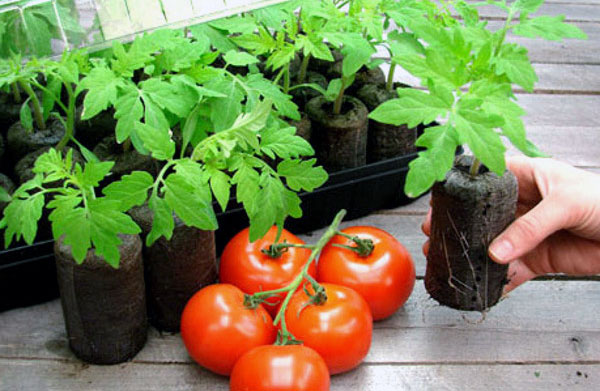
There are different ways to grow tomato seedlings at home for greenhouses and open ground. However, they all have one goal - to grow seedlings strong and productive.
The process of growing seedlings can be divided into several stages:
- seed preparation;
- cursed;
- sowing;
- picking;
- transplanting in open ground or greenhouse.
Seed preparation
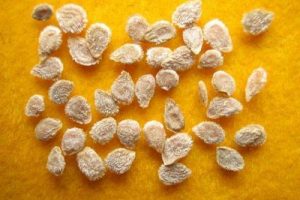 Buying seeds in the store, you can sometimes see that the seed has a coloring. Some seeds are covered with a special composition, which includes trace elements and fungicidal preparations. Such seeds have a multi-colored shell and no longer require additional soaking, moreover, such a soaking is even harmful, since it will wash away trace elements.
Buying seeds in the store, you can sometimes see that the seed has a coloring. Some seeds are covered with a special composition, which includes trace elements and fungicidal preparations. Such seeds have a multi-colored shell and no longer require additional soaking, moreover, such a soaking is even harmful, since it will wash away trace elements.
Something similar implies the Chinese way of growing seedlings of tomatoes, the Terekhins' method of growing tomatoes. In this method, the seeds are soaked in suspension which is prepared from:
- hot water - 1l;
- oven ash - 2 tbsp. spoons.
Seeds are kept in suspension for 3 hours, and then transferred to a solution that has fungicidal properties:
- water - 1 l;
- potassium permanganate - 1 g.
Next, Terekhins recommend putting the seeds in Appin solution for 1 night and then in the fridge for a day, ostensibly for quenching. But now you can start sowing.
Seeding methods
All possible and tested methods of sowing tomato seeds can be divided into:
- soil (sowing in the ground);
- diving seedlings;
- without a dive.
- without soil (in snails, diapers, toilet paper).
See also: Tomato varieties of Siberian selection with photos and descriptions
Sowing in the ground
On the method of cultivation chosen and the container in which it will be grown depends. If the method without picking is chosen, this means that each individual seed must have its own “dwelling”, and this tomato will grow in it until the time it is planted in open ground, or a greenhouse.
Group method
A box with a height of 10-15 cm is selected. It is filled with a ground mixture, compacted, seeds are laid out on the ground with a distance of 5x5 cm, covered with earth, covered with foil and set to germinate.
You can not thicken the crops, if you do not plan to plant grown plants.
If there are a lot of varieties, it is possible to take a container, a box, a flower pot for each separately, or you can divide the box into spaces by placing preliminary labels.
If picking up seedlings is supposed, then crops can be carried out on a lot of thick. A distance of 1x1 cm is quite enough, because tomatoes will stay in this capacity for a very short time.
Individual method
This method involves using for each seed a separate pot, plastic cup, cup, rolled out of paper, newspaper, plastic film, peat seedlings are used, that is, everything that will allow the root system to develop autonomously and individually.
Experienced growers begin the process of growing from small cups with a capacity of 50 g (plastic glasses). When the seedlings grow up and master the earthy lump, they do the transshipment into cups with a capacity of 200 g, and further, if the plant requires it in 0.5 l glasses.
For the cultivation of seedlings, craftsmen use everything they can, milk and juice bags, used cups and cut bottles, plastic packaging made from sour cream, mayonnaise and yogurt, in general, everything that can be used.
As it turned out, tomato seedlings in eggshell are also possible. When using eggs, the shell is broken very carefully, so that most of it is as complete as possible. A small hole is made in the bottom with an awl, to drain the water, pour in the soil and sow the seed. The shell is set in a paper or plastic tray from under the eggs and seedlings are grown there. This method provides for planting along with the shell, without destroying it.
The one who has already managed to use the planting with a shell, realized that the shell is not able to decompose in one season, so when planting it is necessary to break its integrity (flare), or to give preference to another method due to the fact that the root system in the shell of chicken eggs closely, and ostrich expensive.
See also: Tomato "Intuition": reviews, photos, yield
Peat tablets
As for peat tablets, this method is very good, but each plant planted will increase its cost by the price of a tablet, and if you need a lot of seedlings, then the investment will not be small.
In fairness it should be noted that peat tablets are simply universal for growing seed of tomatoes. The composition of them is balanced and has all the necessary nutrients for a friendly start, on which sometimes depends on fruiting.
Using peat tablets there is no need for cups and other containers, however, a huge stand is needed where peat tablets will be installed and this imposes its own imprint. Although the people succeeded in this and decided to use the same milk bags, only spread across and cut. In the course are plastic covers from cakes, containers, sudochki and everything that can be adapted.
The convenience of peat tablets consists in the fact that planting goes along with them, while the earthen clod is not disturbed and time is not spent on removing containers and shaking out seedlings.
Sowing diapers
Not so long ago, gardeners captured a wave of "snails" and "diapers". Many have already managed to try and have their own opinion on this matter. Some liked it, while others returned to the traditional methods of growing seedlings.
The seedlings in diapers from the film are grown with an indispensable dive, because the amount of soil that can accommodate the “diaper” is very small and the development of the root system in it is not possible.
From a polyethylene film, strips of 20 cm width are cut and spread on the table. A soil mixture is applied to the central part with a layer of 1 cm, compacted, and tomato seeds lie on top with a distance of 2-3 cm. From above, the seeds are covered with a layer of 1-1.5 cm. The bottom edge of the film is rolled up and everything is rolled up. This “garden” is set in a container, it is poured from a spray bottle and sent to a warm place for germination.
As soon as the first shoots appear, a soil mixture is added to the inside of the cochlea and placed on the lightest window sill or under the phyto lamp.
Growing takes place before the appearance of the first true leaf. Next, the diaper unfolds, and the seedlings spike in individual cups.
Maybe the method is good, that's just not clear why such difficulties, what is the difference between this method and simple sowing of seeds in a pot, followed by picking?
Sowing without soil
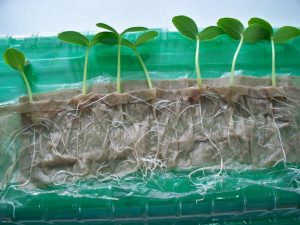 Growing seedlings in "snails" is that the seeds are laid out and folded by a snail, and then it germinates. In order to do this, it is necessary to pre-cut plastic tapes, put a layer of toilet paper, wet it and spread out the seeds with a distance of 1 cm, retreating from the edge of 1-1.5 cm. The width of the strip is 10-12 cm.All this is rolled up and installed in a container with water poured to the bottom. Put on a plastic bag and put in a warm place to germinate.
Growing seedlings in "snails" is that the seeds are laid out and folded by a snail, and then it germinates. In order to do this, it is necessary to pre-cut plastic tapes, put a layer of toilet paper, wet it and spread out the seeds with a distance of 1 cm, retreating from the edge of 1-1.5 cm. The width of the strip is 10-12 cm.All this is rolled up and installed in a container with water poured to the bottom. Put on a plastic bag and put in a warm place to germinate.
The seed germinates and the sprout reaches for the light. As soon as two true leaves appear, it is necessary to proceed with the picking. The snails unfold and there is such a pattern that the seedlings in toilet paper without soil are stretched beyond recognition. When diving, it should be planted in the nutrient soil on the seedbed leaves, and then carefully looked after.
In this method, the seedlings grow only due to the water and nutrients of the seed, naturally, it is thin and weak, therefore not all vegetable growers have approved this method. The method also does not bring significant savings in space, time, and energy.
See also: Tomato "Mazarin": characteristics and description of the variety, reviews
Economical method - low-spreading
Experienced vegetable growers have long abandoned varietal tomatoes. It has long been proven that the yield, sustainability, profitability of hybrids is higher, however, and the cost of seed is higher at times.
If there is a need for a large number of seedlings, and the cost of the seed is high, you can increase the yield of seedlings from one seed.
Buying hybrid expensive seed, it is usually processed and does not require additional manipulations. Sowing in the ground and growing seedlings to a level of 20 cm is carried out. Next, vershoks are cut off over the first pair of true leaves. The tip of the cutting is dipped into root powder (in some varieties and hybrids, and without it, the cutting gives roots well, and some tugovat) and is placed in a vessel with water. "Stump", in which the stalk is cut, continues to grow and produces two stepsons from the internodes, and the stalk is rooted in the soil.
Further, when the stepchildren grow up, they can also be cut off and rooted, and the maternal “stump” will continue to produce stepchildren.
Thus, from one seed it is possible to take up to 10 seedlings, which will begin to bear fruit earlier than those grown on their own roots.
The considered methods can be improved to infinity, combine, add something of your own, rebuild and revise until some method is chosen that suits you exactly according to your specific conditions. It makes no sense to abandon experimentation, but in any case, it is necessary to make a conclusion and think about the fact that we win.

